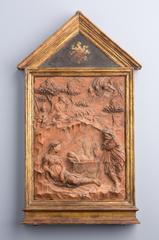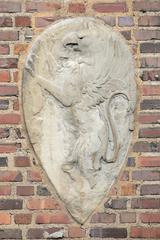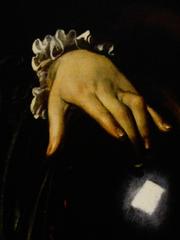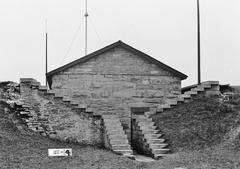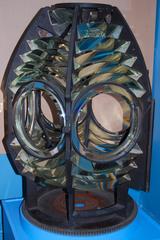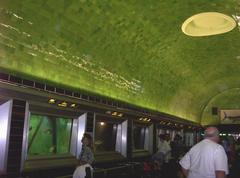
Visiting the Detroit Institute of Arts: Hours, Tickets, and Tips
Date: 17/07/2024
Introduction
The Detroit Institute of Arts (DIA) is a cultural cornerstone located in the heart of Detroit, Michigan. Established in 1885, the DIA has grown from a modest collection of European and American art to one of the most significant art museums in the United States. Initially housed on Jefferson Avenue, the museum moved to its current location on Woodward Avenue in 1927, into a Beaux-Arts building designed by the renowned architect Paul Philippe Cret. This architectural masterpiece, coupled with the museum’s extensive collection, makes the DIA a must-visit destination for art enthusiasts and casual visitors alike (DIA History).
One of the DIA’s most iconic features is the Detroit Industry Murals by Diego Rivera, completed in 1933. These murals, located in the Rivera Court, are celebrated for their artistic brilliance and social commentary, depicting the industrial life of Detroit’s automotive industry. The murals are a National Historic Landmark and a testament to the museum’s commitment to showcasing art that reflects the city’s cultural and historical landscape (Detroit Industry Murals).
The DIA’s collection is vast and diverse, encompassing over 65,000 works of art from various periods and regions, including masterpieces by Vincent van Gogh, Pieter Bruegel the Elder, and an extensive collection of African American art. The museum is also a vital cultural and educational institution, offering a wide range of programs designed to engage the community and foster an appreciation for the arts (DIA Collection).
For those planning a visit, the DIA offers a rich and rewarding experience with its extensive galleries, special exhibitions, and educational programs. The museum is open from Tuesday to Sunday, with varying hours, and offers free admission to residents of Wayne, Oakland, and Macomb counties. With its commitment to accessibility, the DIA ensures that art is available to all, making it a cornerstone of Detroit’s vibrant cultural heritage.
Table of Contents
- Introduction
- Founding and Early Years
- The Move to Woodward Avenue
- Diego Rivera’s Detroit Industry Murals
- Expansion and Growth
- The Collection
- Visiting Hours and Tickets
- Cultural and Educational Significance
- Financial Challenges and Public Support
- Community Engagement and Accessibility
- Technological Innovations
- Nearby Attractions and Travel Tips
- Future Prospects
- FAQ
- Conclusion
Founding and Early Years
The Detroit Institute of Arts (DIA) was founded in 1885, originally housed in a building on Jefferson Avenue. The museum’s establishment was driven by a group of Detroit citizens who recognized the need for a cultural institution to serve the growing city. The initial collection was modest, consisting mainly of European and American art, but it laid the foundation for what would become one of the most significant art museums in the United States.
The Move to Woodward Avenue
In 1927, the DIA moved to its current location on Woodward Avenue, a Beaux-Arts building designed by the prominent architect Paul Philippe Cret. This move was a significant milestone, as it provided the museum with a more spacious and architecturally significant home. The building itself is a work of art, featuring a grand marble facade and intricate interior details that reflect the grandeur of early 20th-century design.
Diego Rivera’s Detroit Industry Murals
One of the most iconic features of the DIA is the Detroit Industry Murals by Diego Rivera, completed in 1933. These murals, located in the Rivera Court, are considered some of Rivera’s finest works and are a National Historic Landmark. The murals depict the city’s industrial life, highlighting the workers and machinery of Detroit’s automotive industry. Rivera’s work is celebrated for its artistic brilliance and its social and political commentary, making it a must-see for visitors (Detroit Industry Murals).
Expansion and Growth
The DIA has undergone several expansions and renovations to accommodate its growing collection and to enhance the visitor experience. Notable expansions include the North and South Wings added in the 1960s and the more recent renovation completed in 2007. This renovation, which cost $158 million, included the addition of new galleries, improved visitor amenities, and the restoration of the original building’s architectural features (DIA Renovation).
The Collection
The DIA’s collection is vast and diverse, encompassing over 65,000 works of art. It includes masterpieces from various periods and regions, such as European paintings, American art, African art, Asian art, and contemporary works. Highlights of the collection include Vincent van Gogh’s “Self-Portrait,” Pieter Bruegel the Elder’s “The Wedding Dance,” and an extensive collection of African American art (DIA Collection).
American Art
The American Art collection includes works from the colonial period to the present day. Highlights include John Singleton Copley’s “Watson and the Shark,” Frederic Edwin Church’s “Cotopaxi,” and works by American Impressionists such as Childe Hassam. The collection also features significant pieces from the 20th century, including works by Georgia O’Keeffe and Jackson Pollock.
European Art
The European Art collection features masterpieces from the Renaissance to the 19th century. Notable works include Pieter Bruegel the Elder’s “The Wedding Dance,” Vincent van Gogh’s “Self-Portrait,” and Rembrandt’s “The Visitation.” The collection also includes significant works by artists such as Peter Paul Rubens, Claude Monet, and Edgar Degas.
African Art
The African Art collection is renowned for its breadth and depth, encompassing a wide range of media, including sculpture, textiles, and ceramics. Highlights include a 16th-century Benin bronze plaque, a 19th-century Yoruba mask, and contemporary works by African artists such as El Anatsui.
Asian Art
The Asian Art collection spans over 5,000 years and includes works from China, Japan, Korea, India, and Southeast Asia. Highlights include Chinese ceramics from the Tang and Song dynasties, Japanese woodblock prints, and Indian miniature paintings. The collection also features significant Buddhist sculptures and textiles.
Islamic Art
The Islamic Art collection includes works from across the Islamic world, from Spain to India. Highlights include a 10th-century Iranian bowl, a 16th-century Ottoman tile, and a 17th-century Mughal manuscript. The collection also features significant examples of Islamic calligraphy and textiles.
Native American Art
The Native American Art collection includes works from across North America, from the Arctic to the Southwest. Highlights include a 19th-century Haida totem pole, a Navajo chief’s blanket, and contemporary works by Native American artists such as Jaune Quick-to-See Smith.
Modern and Contemporary Art
The Modern and Contemporary Art collection includes works from the late 19th century to the present day. Highlights include works by Pablo Picasso, Henri Matisse, and Diego Rivera. The collection also features significant works by contemporary artists such as Kara Walker and Julie Mehretu.
Visiting Hours and Tickets
The Detroit Institute of Arts is open from Tuesday to Thursday from 9 a.m. to 4 p.m., Friday from 9 a.m. to 10 p.m., Saturday from 10 a.m. to 5 p.m., and Sunday from 10 a.m. to 5 p.m. The museum is closed on Mondays. General admission is free for residents of Wayne, Oakland, and Macomb counties. For non-residents, ticket prices are $14 for adults, $9 for seniors, and $8 for youth. Special exhibition tickets may have additional costs (DIA Tickets).
Cultural and Educational Significance
The DIA is not just a repository of art; it is a vital cultural and educational institution. The museum offers a wide range of educational programs, including school tours, art classes, and lectures. These programs are designed to engage the community and foster an appreciation for the arts. The DIA also hosts special exhibitions, bringing world-class art to Detroit and attracting visitors from around the globe.
Financial Challenges and Public Support
In recent years, the DIA has faced significant financial challenges, particularly during the Detroit bankruptcy crisis in 2013. There were concerns that the museum’s collection could be sold to pay off the city’s debts. However, a “Grand Bargain” was reached, which involved contributions from foundations, the state of Michigan, and private donors to protect the museum’s collection and support the city’s pension funds (Detroit Bankruptcy).
Community Engagement and Accessibility
The DIA is committed to making art accessible to all. In 2012, voters in Wayne, Oakland, and Macomb counties approved a millage that provides free general admission to residents of these counties. This initiative has significantly increased attendance and has made the museum more accessible to a broader audience. The DIA also offers various community outreach programs, including partnerships with local schools and community organizations (DIA Millage).
Technological Innovations
The DIA has embraced technology to enhance the visitor experience. The museum offers a mobile app that provides detailed information about the collection, interactive maps, and audio tours. Additionally, the DIA has implemented augmented reality (AR) experiences, allowing visitors to engage with the art in new and innovative ways. These technological advancements have made the museum more engaging and accessible to a tech-savvy audience (DIA Technology).
Nearby Attractions and Travel Tips
Visitors to the DIA can also explore other nearby attractions, such as the Detroit Historical Museum, the Motown Museum, and the Charles H. Wright Museum of African American History. Travel tips include using the QLINE streetcar for convenient transportation along the Woodward Avenue corridor and checking for any special events or exhibitions that may be taking place during your visit.
Future Prospects
Looking ahead, the DIA continues to evolve and adapt to the changing cultural landscape. The museum is committed to expanding its collection, enhancing its educational programs, and increasing its community engagement efforts. With its rich history, diverse collection, and commitment to accessibility, the DIA remains a cornerstone of Detroit’s cultural life and a must-visit destination for art lovers.
FAQ
What are the visiting hours for the Detroit Institute of Arts?
The DIA is open from Tuesday to Thursday from 9 a.m. to 4 p.m., Friday from 9 a.m. to 10 p.m., Saturday from 10 a.m. to 5 p.m., and Sunday from 10 a.m. to 5 p.m. The museum is closed on Mondays.
How much are tickets to the Detroit Institute of Arts?
General admission is free for residents of Wayne, Oakland, and Macomb counties. For non-residents, ticket prices are $14 for adults, $9 for seniors, and $8 for youth. Special exhibition tickets may have additional costs.
Are there guided tours available at the DIA?
Yes, the DIA offers guided tours that provide in-depth insights into the collection and special exhibitions.
What are some nearby attractions to the DIA?
Nearby attractions include the Detroit Historical Museum, the Motown Museum, and the Charles H. Wright Museum of African American History.
Conclusion
In conclusion, the Detroit Institute of Arts stands as a beacon of cultural enrichment and historical significance in Detroit. From its founding in 1885 to its current status as one of the most esteemed art museums in the United States, the DIA has continually evolved and adapted to meet the needs of its community and visitors. The museum’s diverse collection, which includes iconic works by Diego Rivera, Vincent van Gogh, and Pieter Bruegel the Elder, offers a comprehensive journey through art history that is both educational and inspiring (DIA Collection).
The DIA’s commitment to accessibility and community engagement is evident through its free admission policy for local residents, extensive educational programs, and technological innovations like the mobile app and augmented reality experiences. These efforts have made the museum more inclusive and engaging, attracting visitors from all walks of life (DIA Technology).
Despite facing financial challenges, particularly during the Detroit bankruptcy crisis, the DIA has demonstrated resilience and adaptability, securing its future through public support and strategic initiatives. The museum’s ongoing efforts to expand its collection, enhance visitor experiences, and foster community involvement ensure that it remains a vital cultural institution for generations to come (Detroit Bankruptcy).
For anyone visiting Detroit, the DIA is a must-see destination that offers a unique and enriching experience. Whether you are a seasoned art aficionado or a casual visitor, the Detroit Institute of Arts promises a memorable journey through the world of art and culture. Plan your visit today and immerse yourself in the artistic treasures that make the DIA a cornerstone of Detroit’s cultural life.
References
- Detroit Institute of Arts - Visiting Hours, Tickets, and Historical Significance, 2023, Detroit Institute of Arts link
- Explore the Detroit Institute of Arts - Visiting Hours, Tickets, and Must-See Exhibitions, 2023, Detroit Institute of Arts link
- Detroit Institute of Arts - Visiting Hours, Tickets, and Essential Tips, 2023, Detroit Institute of Arts link
- Detroit Bankruptcy Plan Approved, 2014, The New York Times link

